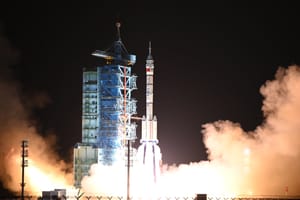
Apr 8, 2024
Dongfanghong-2 - 40 years ago today
On the 8th of April 1984, a Long March 3 lifted off from Launch Complex 3 of the Xichang Satellite Launch Center bound for a geostationary transfer orbit. Aboard the rocket was the Dongfanghong-2 communications satellite.
Dongfanghong-2 was part of the Shiyong Tongbu Tongxing Weixing (實用定位通訊衛星), which literally means Operational Geostationary Communications Satellite in English, group of geostationary communications satellites, the group was commonly abbreviated to STTW. Dongfanghong-2 was also believed to be the name of the satellite bus used for the STTW satellites.
The satellite was the first communications satellite from China to enter geostationary orbit, making China the fifth country to do so. It would also be the first of five Dongfanghong-2 satellites to do so.

The Shiyong Tongbu Tongxing Weixing (實用定位通訊衛星) satellites were developed as part of Project 331 in the 1970s and 1980s with support from Deng Xiaoping, defacto leader of China from 1978 to 1990, and Zhou Enlai, Premier of China from 1954 to 1976, as a part of efforts to improve China's communications infrastructure.

The first STTW satellite to be launched did not enter geostationary orbit. STTW-T1 was launched on the 29th of January 1984 and was stranded in low Earth orbit after the third-stage engine of the Long March 3 failed to re-ignite. However, Teams on the ground did test the satellites' systems while it was in low Earth orbit and over China.
The second, launched on the 8th of April 1984, and third, launched on the 1st of February 1986, STTW satellites, dubbed STTW-T2 and STTW-T3, were both successfully placed into a geostationary transfer orbit by the Long March 3 as planned. To enter geostationary orbit, both satellites had an FG-15 small solid rocket motor kick-stage that was designed specifically to put the spacecraft into their intended orbits.
The first three STTW satellites, built on the Dongfanghong-2 bus, led the way for the next four communications satellites, built on the Dongfanghong-2A bus. The following four STTW satellites would later be dubbed ChinaSat 1 through 4 and would serve both civilian and military communication needs. ChinaSat 4 however was lost when the third-stage of the Long March 3 failed during its burn to geostationary transfer orbit. The four satellites using the Dongfanghong-2A bus would use an FG-15B small solid rocket motor kick-stage to enter geostationary orbit.

The Shiyong Tongbu Tongxing Weixing (實用定位通訊衛星) satellites were 2.1 meters in diameter and 3.1 meters tall, the satellites were believed to be 8.5 meters tall once the antenna was deployed in space. In geostationary orbit, the satellites weighed approximately 441 kilograms. The solid rocket motor kick-stages that placed the satellites in geostationary orbit are believed to have weighed 580 kilograms. For power, the satellites had twenty-thousand solar cells attached to the sides, while behind the Earth the spacecraft used battery power. The spacecraft also had a parabolic antenna mounted on the top, which would be rotated to be kept aligned with receiving stations on the Earth below.
Each satellite was believed to have provided two-hundred telephone lines and fifteen television and radio channels. They also provided a communications link between eastern China and its coastal regions in the west.
At the end of each of the satellites' operations in geostationary orbit, they were sent to a graveyard orbit higher than their previous orbits. Each satellite had a designed operating life of four and a half years.



